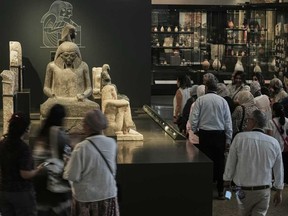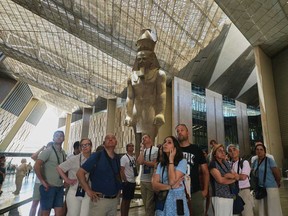
Contents of the article
CAIRO – After two decades of anticipation and countless delays, the Grand Egyptian Museum is finally unveiling its grand opening.The museum, which officially opens on Saturday, showcases Egypt's ancient civilization and is the centerpiece of the government's efforts to boost the tourism industry, a major source of foreign currency in the cash-strapped country.
Advertisement 2
Contents of the article
Located just outside Cairo, next to the famous Pyramids of Giza, the giant $1 billion facility is poised to become the world's largest museum dedicated to a single civilization, with more than 50,000 artifacts detailing life in ancient Egypt. For comparison, the Louvre in Paris has about 35,000 exhibits.
Contents of the article
Contents of the article
The museum is one of the megaprojects backed by President Abdel-Fattah el-Sissi, who has embarked on massive infrastructure investments since taking office in 2014 to revive an economy weakened by decades of stagnation and battered by unrest following the 2011 Arab Spring uprising.
Construction of the museum began in 2005, but work was suspended for three years due to political turmoil following the 2011 uprising.
Contents of the article
Advertisement 3
Contents of the article
The grand opening has been delayed several times, most recently in July this year due to conflicts in the Middle East. World leaders are expected to attend the opening ceremony on Saturday.
Giant building overlooking the Pyramids of Giza
Known as GEM, the museum, designed by Irish firm Heneghan Peng Architects, boasts a tall, triangular glass façade that mimics the nearby pyramids.
In its entrance atrium stands a granite colossus of one of Egypt's most famous pharaohs, Ramesses the Great. The 3,200-year-old, 11-meter (36-foot) tall statue was moved to the museum after decades standing in the center of a traffic-choked roundabout in front of Cairo's main train station.

From the atrium, a majestic six-story staircase decorated with ancient statues leads to the main galleries, which offer views of the nearby pyramids. The bridge connects the museum to the pyramids, allowing tourists to travel between them either on foot or in electric, eco-friendly vehicles, museum officials said.
Advertisement 4
Contents of the article
The museum includes 24,000 square meters (258,000 sq ft) of permanent exhibition space, a children's museum, conference and educational facilities, and a commercial area, as well as a large conservation center.
The 12 main galleries, which opened last year, display antiquities ranging from prehistoric times to the Roman era, organized by era and theme.
Many of GEM's 50,000 artifacts were moved from the Egyptian Museum, a crowded century-old building in Tahrir Square in central Cairo. Others have been recently discovered in ancient cemeteries, including the Saqqara necropolis, another complex of pyramids and tombs, about 14 miles (22 kilometers) south of the museum.
The halls are equipped with cutting-edge technology and feature multimedia presentations, including mixed reality shows, that will help explain ancient Egypt to new generations, according to Ahmed Ghoneim, the museum's general director.
Advertisement 5
Contents of the article
“We’re using the language that Generation Z is using now,” he said in an interview. “Generation Z no longer uses the labels we read as older adults, but rather uses technology.”
Tutankhamun's collection in one place for the first time
The grand opening on Saturday will include the opening of two rooms dedicated to the 5,000 artifacts from King Tut's collection.
The collection is on display in its entirety for the first time since British archaeologist Howard Carter discovered Tutankhamun's tomb in 1922 in the southern city of Luxor. The old Egyptian museum did not have enough space to display all the treasures of the tomb at once.
Some masterpieces were restored at the museum's conservation center, including three burial beds of a boy pharaoh and six chariots, said Jailan Mohamed, chief conservator at the conservation center.
Advertisement 6
Contents of the article
They will be displayed along with his golden throne, gold-plated sarcophagus and funerary mask made of gold, quartzite, lapis lazuli and colored glass. The mask's beard was accidentally knocked off and hastily epoxyed in place in 2014 before a German-Egyptian team of experts repaired it the following year.
Another centerpiece of the museum is the 4,600-year-old solar boat of King Khufu, the pharaoh credited with building the Great Pyramid of Giza. The 43-metre (140-foot) wooden boat, discovered in the 1950s, was buried next to the Great Pyramid for Khufu – or Cheops as he is also known – for use in the afterlife. In 2021, it was transported from its display site at the pyramids to the Grand Egyptian Museum in a remote-controlled car imported from Belgium.
Advertisement 7
Contents of the article
Government hopes museum will revive tourism
The government hopes the museum will attract more tourists to stay for a while and provide the foreign currency Egypt needs to prop up its economy.
The tourism sector has suffered from years of political turmoil and violence since the 2011 Arab Spring uprising. In recent years, the sector has begun to recover from the coronavirus pandemic and the consequences of Russia's war with Ukraine. Both Russia and Ukraine are the main source of tourists visiting Egypt.
The country welcomed a record 15.7 million visitors in 2024, according to official figures, and the government aims to attract 30 million visitors by 2032.
The authorities have overhauled the entire area around the museum and the pyramids. The roads have been paved and a metro station is being built outside the museum gates to make the sites easier to access. Sphinx International Airport has also opened to the west of Cairo, 40 minutes from the museum.
Hassan Allam, CEO of Hassan Allam Holding, the firm running the museum, said they expect 15,000 to 20,000 visitors a day at the museum.
“The world has been waiting… Everyone is excited,” he said.
Contents of the article





:quality(85):upscale()/2024/10/10/100/n/1922729/e97c0b6567087e489a9fe8.04809759_.jpg?w=150&resize=150,150&ssl=1)

